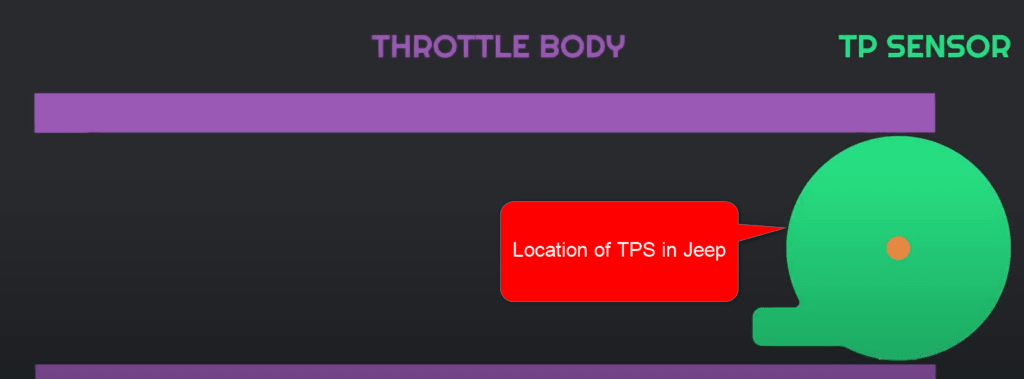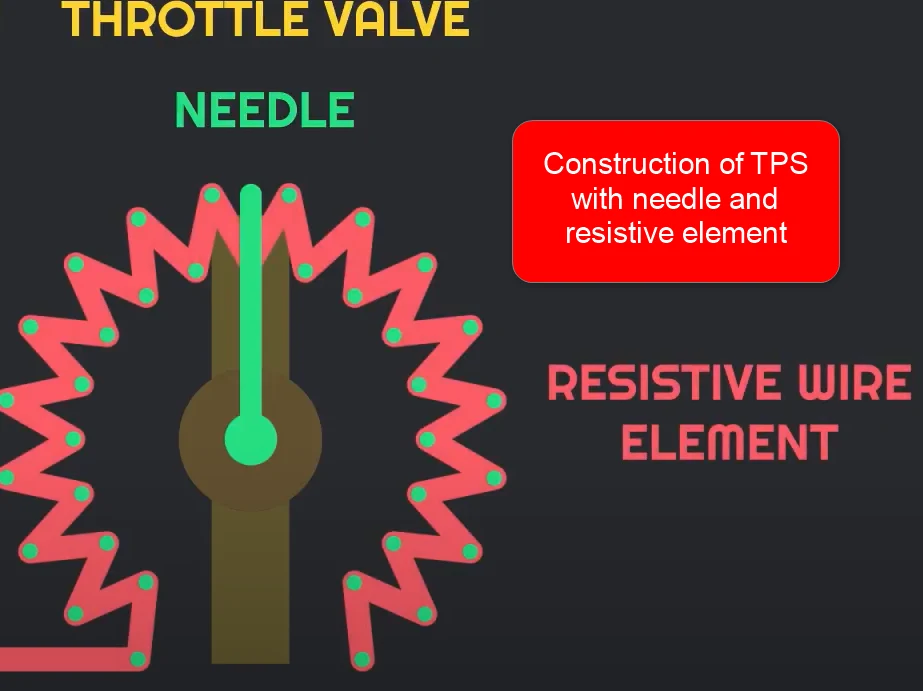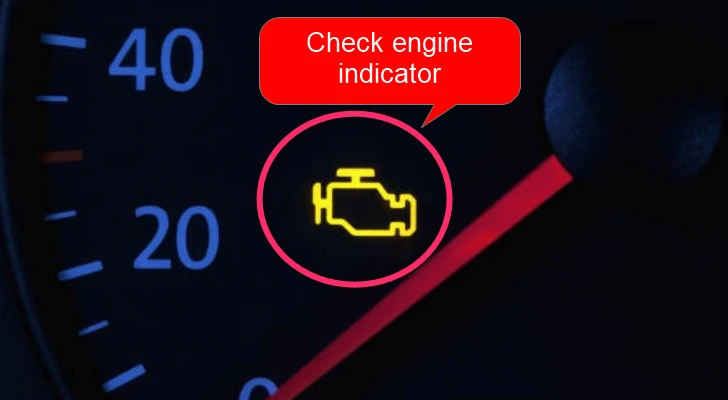As a driver, you rely on your vehicle’s performance to get you from point A to point B safely and efficiently. However, when certain components start to malfunction, it can be not only frustrating but also dangerous. This is especially true when it comes to the throttle position sensor on your Jeep. But how do you know if it’s the culprit behind your car troubles?
Symptoms of a bad throttle position sensor (TPS) on Jeep include:
- Check engine light
- Lag in acceleration
- Tachometer RPM counter abnormality
- Lack of power
- Facing annoying jerks
- Poor fuel economy
- Problems during gear shifting
- Electrical system malfunctioning
- Poor idling
- Limp mode
In this article, I’ll explore 13 symptoms of a bad throttle position sensor on a Jeep and discuss replacement options and costs. So buckle up, and let’s dive into the world of Jeep throttle position sensors.
What is Throttle Position Sensor and How Does It Work in Jeep?
The throttle position sensor (TPS) is an essential component of a Jeep’s engine that plays a vital role in transmitting information about the position of the throttle to the electronic control module.
This information is critical to regulating your engine’s fuel injection and ignition timing, ensuring optimal performance.
The TPS is located on the throttle body's side and connected to the throttle shaft. It consists of a potentiometer, a variable resistor that changes its resistance according to the position of the throttle.

As the throttle is opened, the resistance of the potentiometer changes, and the TPS transmits this data to the ECM.

The ECM then uses this data to adjust the fuel and air mixture for optimal engine performance, considering factors such as engine load and operating conditions.
In this way, the TPS helps to maintain the correct air/fuel ratio in the engine, preventing it from running too lean or too rich, which can cause damage to the engine.
Symptoms of Bad Throttle Position Sensor:
Now that you know how TPS works let me discuss the most common symptoms of a bad TPS:
1. Pop-Up of Check Engine Light:
One of the most common symptoms of a bad TPS is the illumination of the check engine light. The computer system in your Jeep is designed to automatically scan for any malfunctions in the engine, transmission, or suspension, and it immediately senses any issues with the TPS.

When this happens, the check engine light will pop up in the instrument cluster, warning the driver to get the vehicle checked by a certified mechanic.
Here, I’ll list down the relevant engine code for a bad TPS for your convenience:
DTC (Diagnostic Trouble Code) | Descriprion |
P0121 | The output voltage of TPS A is either higher or lower than the threshold. |
P0122 | The output voltage of TPS A is lower than the threshold. |
P0123 | The output voltage of TPS A is higher than the threshold. |
P0124 | TPS circuit intermittent |
P2135 | TPS A or B transmits an erroneous signal to ECM |
P2138 | TPS D or E circuit failure |
2. Lag in Acceleration:
One of the most noticeable symptoms of a bad TPS is a lag in acceleration. When the TPS fails, it may not send the correct signal to the ECM, which can delay or hold the engine’s response to the accelerator pedal.
This means that when you press on the gas pedal, the vehicle may not accelerate as quickly as it should, or it may not accelerate at all.
This can be particularly dangerous when trying to merge onto a highway or pass another vehicle.
3. Tachometer RPM Counter Abnormality:
The tachometer is a gauge that measures the engine’s rotations per minute, and its movements are typically correlated with the throttle position.
However, when the TPS fails, it can cause erratic behavior in the tachometer, leading to fluctuations in the RPM counter even when the gas pedal is not depressed.
These fluctuations can create the impression of someone meddling with the gas pedal, but they are, in fact, the result of voltage fluctuations caused by the faulty TPS.
4. Lack of Power in Vehicle:
Next symptoms of a bad TPS is a lack of power in the vehicle. When the TPS fails to respond to the requirement of air and fuel to the engine, the vehicle becomes sluggish, and the required power is not delivered, no matter how hard the driver hits the pedal.
As soon as you push down, the TPS should give the signal to add fuel, but if it’s not functioning properly, it won’t.
5. Facing Annoying Jerks during Driving:
Another common sign of a faulty TPS is experiencing annoying jerks while driving. These jerks occur due to the lack of fuel supply by the throttle body to the fuel pump.
As a result, the vehicle struggles to maintain a steady speed, which affects the driving experience.
The jerks could also restrict the transmission from upshifting or downshifting where needed, leading to more frustration for the driver.
6. Poor Fuel Economy:
The combustion rate increases when the throttle body stops sending the needed fuel to the engine. Unfortunately, this causes your vehicle to start guzzling more fuel, dropping the average fuel economy to an abnormal value.
Not only is this a pain in the neck for the user, but it also means you’ll be spending more money at the pump until the issue is fixed.
The disturbed fuel ratios caused by a bad TP sensor can fluctuate the airflow or create a wide-open throttle. In either case, the engine will run on an improper mixture and waste fuel.
This will also cause sluggish engine performance as well due to much of the power being squandered away.
7. Problems during Gear Shifting:
The vehicle’s transmission becomes less responsive to the driver’s needs. As a result, where upshifting is required, a bad throttle position sensor would restrict the vehicle from shifting gears.
Also, when downshifting is required, the bad throttle position sensor restricts the vehicle from downshifting, and the driver feels sluggish to the driver.
8. Malfunctioning in the Electrical System:
A bad throttle position sensor would cause more issues, such as electrical malfunctions in the vehicle.
When a TP sensor malfunctions, it often causes a spark in the vehicle’s wiring, which might cause the malfunction of other sensors in the vehicle.
In this case, when the check engine warning light pops up in the instrument cluster, it is best to take action as soon as possible to save the vehicle from further damage..
9. Poor Idling:
When the airflow is compromised, it disturbs the normal idling of the vehicle. For instance, when the vehicle is idling, the bad throttle position sensor would cause it to shut off, which might happen repeatedly. Therefore, it is essential to replace the throttle position sensor once it malfunctions.
10. Engaging Behavior of Limp Mode:
One of the most noticeable symptoms of a bad TPS is the engaging behavior of limp mode. The vehicle has a limp mode programmed so that whenever a throttle position sensor malfunction is detected, the vehicle cuts off its maximum performance and runs at a very minimal performance level.
This mode is engaged and only turned off when the malfunction has been detected and cleared.
Limp mode is designed to protect the engine and transmission from damage by limiting the vehicle's power output. There are quite a few sensors that control the engine and transmission. If one of the sensors, such as the TPS, MAF, MAP, or wheel speed sensors, sends improper signals to the computer, the limp mode can activate.
11. Leakage of Oil:
Several users have faced a common issue of leakage of oil chambers in their vehicles. This might happen due to a faulty throttle position sensor.
Also, the oil chamber might get leaked due to a faulty oil cooler, which has to maintain the normal temperature of the oil within the vehicle, when the engine is turned on.
A faulty oil cooler, along with a bad throttle body, is often responsible for leakage in the oil chamber of the vehicle, and the issue can go away by simply replacing the oil cooler, and the throttle body of the vehicle
12. Disabling of Power Steering:
The next symptom that can arise from a bad throttle position sensor is the disabling of power steering in the vehicle. The power steering system in the Jeep is electronically controlled, which means that it relies on sensors and other electronic components to function properly.
When the throttle position sensor malfunctions, it can cause the power steering system to fail, which can make it difficult or impossible to steer the vehicle.
13. Fault with the Fuel Pump:
The fuel pump of the Jeep has been reported to go faulty by many users due to malfunctioning of the engine’s throttle body. This causes the vehicle to stall or, at other times, doesn’t start the vehicle.
The fuel pump controls the fuel the engine needs to move. If the throttle sensor or the throttle body is not working properly, it will not allow the required amount of fuel to be supplied to the engine then the car will have several issues moving.
Diagnosing a Bad Throttle Body in Jeep:
STEP | Action | Description |
STEP 1 | Locating the throttle body in vehicle | The first step involves diagnosing the throttle body in the Jeep. The throttle body is near the air filter, and the air duct is near the engine. This location is typically seen in vehicles that are manufactured nowadays. But in the case of older vehicles, the throttle body is generally placed near the carburetor. |
STEP 2 | Removing the blocking components | After locating the throttle body, next comes the removal of air intake ducts. You can remove it by loosening its fasteners using a screwdriver. Ultimately, you can loosen the other components blocking access to the throttle body. |
STEP 3 | Visual inspection of throttle body | The next step is the visual inspection of the throttle body to detect the presence of an accumulation of carbon or debris. The presence of these components in the throttle body can delay the acceleration process whenever the person tries to push down the gas pedal. |
STEP 4 | Inspection of electrical connectors | After visual inspection, check out for the presence of any corrosion or rust on the electrical connectors. Corrosion can cause a resistance between the electrical connectors, leading to an issue. |
STEP 5 | Removing the throttle body | After inspecting all the parts, remove the throttle body from the vehicle using a socket set and ratchet handle. You can loosen the bolts using these mechanic tools. |
STEP 6 | Cleaning the throttle body | Clean the clogging of the throttle body thoroughly by flipping it from all sides. Clean away all the horrible spots associated with it. You can use a throttle body cleaner to clean the body and spray it inside the component to clean away the dead spots. |
STEP 7 | Reinstallation of throttle body in Jeep | Before reinstallation of the throttle body in your vehicle, it is recommended to coat its surface with a sealant. Then, tighten the associated bolts with it and fix everything together. |
My Recommendation:
As a seasoned Jeep user, I use the TPS006 Throttle Position Sensor (Amazon) in my 2007 Jeep Grand Cherokee.
This sensor fits perfectly and performs exceptionally well, ensuring a smooth and accurate response from the engine.
Although the TPS and idle air control valve are integrated into the throttle body, this sensor is a great replacement.
Moreover, I must applaud the excellent customer service that accompanies this product – they truly understand the needs of their clients.
Replacing the Throttle Position Sensor of Jeep:
The engine in your vehicle needs a proper inspection to detect any presence of an issue, which can delay its working in the future. If you face any problem and the culprit is a bad throttle position sensor, you can replace it using a high-end sensor.
You can replace the throttle body through these steps:
- STEP 1: The first step is to disconnect the battery’s negative terminal and locate the throttle position sensor in your Jeep. This disconnection is necessary to prevent a short circuit in the vehicle which can create a fault code. The throttle position sensor is typically located on the vehicle’s throttle body.
- STEP 2: The next step is the removal of electrical connectors and unscrewing the throttle position sensor. You can easily remove the electrical connectors by pressing and wiggling its tab. Gently loosen the screws and fasten the bolts of the throttle position sensor.
- STEP 3: Install the new position sensor through the reverse process of installation. Mount the throttle position sensor and install the electrical connectors. Inspect the connectors for corrosion before removing the electrical connectors, as corrosion can cause resistance between the connectors.
- STEP 4: Cross-check all your process of connecting and re-installing. Make sure that all the negative terminals of the battery are tightened. Check the vehicle by running it at idle. You can do this if you need to adjust the sensor manually.
Jeep Throttle Position Sensor Replacement Cost:
If it is determined that the Throttle Position Sensor (TPS) in your Jeep needs replacement, it is essential to understand the associated costs.
On average, replacing a TPS in a Jeep ranges from $115 to $210, with the parts being anywhere from $70 to $1110 and the labor cost ranging from $45 to $100. Additionally, it is essential to consider any additional fees or taxes that may apply.
Therefore, it is recommended that Jeep owners shop around for the most cost-effective mechanic to ensure the replacement job is performed efficiently and cost-effectively.
It is important to address TPS malfunctions as soon as possible to prevent further damage to the engine and maintain optimal vehicle performance.
Final Thought:
Overall, the symptoms of a bad throttle position sensor on a Jeep can cause significant issues, as I mentioned above.
However, it is essential to remember that other vehicle components could cause similar symptoms. That’s why it must be inspected by a professional technician for a proper diagnosis.
Regardless, having a functioning TPS is essential for the overall performance of your Jeep. Don’t hesitate to seek professional help to ensure your vehicle’s safety and optimal performance.
Also Read:
Jeep Oil Change Required- Meaning and How to Reset
Jeep 4.0 Oil Capacity and Type- All You Need to Know
How to Fix ESP BAS Light on Jeep- All You Need to Know
Jeep 2.0 Turbo: Common Problems to Watch Out For
Most Common Jeep 2.4 Engine Problems- How to Fix
Jeep Grand Cherokee Panoramic Sunroof Problems- How to Fix
Jeep Wrangler USB Port Center Console Problems- How to Fix
Frequently Asked Questions (FAQs):
What are some symptoms which indicate the presence of a bad TPS Jeep?
The failure of the throttle position sensor (TPS) shows various signs, including issues with installing and starting, hesitation during acceleration, and much more.
A bad TPS requires quick replacement and should be appropriately diagnosed through a certified mechanic before replacement.
How can a person reset their throttle position sensor on Jeep?
You can reset the throttle position sensor on Jeep by following the steps:
- Release the accelerator pedal at full pace.
- Turn on the ignition switch and wait for a few seconds.
- Turn the ignition switch off and wait for 10 seconds.
- After switching off and waiting, turn the ignition switch to the ‘ON’ position again and wait for two seconds now. After this, you can reset the TPS on your Jeep.
What do you mean by TPS on a Jeep?
TPS on a Jeep stands for the Throttle position sensor.
How can a person test the throttle position sensor?
A person can test the throttle position sensor through the following steps:
- Set the voltage range of the multimeter to 10 DC voltage.
- The next step is to place the black negative probe on the ground terminal of the throttle position sensor.
- Place the red positive probe on the reference terminal of the voltage of the throttle position sensor.
- The meter reading of the multimeter will indicate the working position of TPS. If it is not 5 volts, TPS is in bad condition.
What happens after the failure of the throttle position sensor?
The engine starts to run poorly due to a bad throttle position sensor. The engine shows difficulty in acceleration but works better during the idling state.
The airflow mechanism of the vehicle increases, but the computer system does not properly tell the engine about fuel injection.
What are some main symptoms which indicate a faulty throttle position sensor?
Some symptoms indicate a bad throttle position sensor:
- Jerking sound of a vehicle
- Surging of idling of vehicle
- Stalling the engine without any visible reason
- Hesitation during acceleration of the vehicle
- Surging behavior in speed during driving of the vehicle
- Flashing of engine light in the vehicle.
Is there any fuse available for the TPS in a vehicle?
Yes, there is a fuse confined for TPS in the vehicle. You can reset the throttle position sensor by unhooking the negative cable of the battery or by removing the fuse of your engine control module.
Which thing is responsible for controlling the throttle position sensor in the vehicle?
A throttle valve in the vehicle controls the throttle position sensor. The valve opens after compression of the accelerator pedal.
TPS helps to measure the throttle valve and controls the amount of air that flows toward the engine.

This is Surya. I am an experienced off-roader. I have been off-roading for many years across several terrains. I am passionate about 4×4 driving and want to share my knowledge and experience with others.
My goal is to provide you with the most comprehensive and unbiased information about off-roading.
I curated this article through my personal experience and expertise, and I hope it helps you with what you are looking for.

 (+91)9123743026
(+91)9123743026
 24/1 Nibedita Sarani. M.B. Road, Kolkata- 700051, India
24/1 Nibedita Sarani. M.B. Road, Kolkata- 700051, India